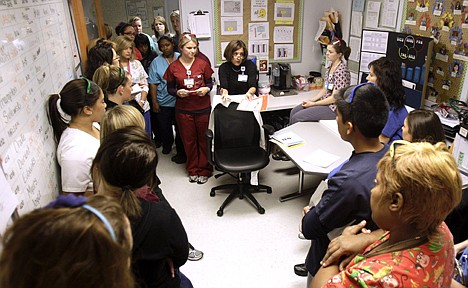The germ police
BALTIMORE - This is no ordinary intensive care unit: Every doctor, nurse, friend or loved one must cover their clothes with a bright yellow gown and don purple gloves before entering a patient's room so some scary germs don't hitch a ride in or out.
It's part of the University of Maryland Medical Center's crackdown on hospital-spread infections, and Michael Anne Preas patrols the ICU like a cop on the beat to help keep bacteria in check.
You forgot your gloves, Preas leans in to tell a doctor-in-training who's about to examine a man with a breathing tube. Startled, the resident immediately washes his hands and grabs a pair.
Peering at the IV tube inserted into another patient's neck, Preas spots a different opening for bacteria: His long beard is messing up what should be an airtight seal. Let's shave that spot and put in a new catheter, she tells the nurse.
Nor does a janitor escape Preas' inspection. Yes, she put on clean gloves between collecting trash and moving carts that nurses will touch.
Infections caught at health care facilities are one of the nation's leading causes of preventable death, claiming an estimated 99,000 lives a year. Yet chances are you've never heard of Preas' job: She's an infection preventionist, part of an evolution under way as hospitals are pushed to slash those rates or lose lucrative Medicare dollars.
"You have to be out and about," says Preas, who with a team of four other specialists checks parts of this large Baltimore teaching hospital for infection-control steps, looking to identify the inevitable spots where fast-paced care can allow the bugs an entry. Doctors and nurses are under orders to heed their advice.
The program is unusual. There are only about 8,000 to 10,000 infection preventionists nationwide, and in most smaller hospitals they're occupied with documenting infection statistics or advising doctors about specific pathogens, according to the Association for Professionals in Infection Control and Epidemiology.
But with some other steps, it's starting to pay off: This surgical ICU has gone 24 weeks without a single case of one of the most insidious hospital infections, where bacteria infiltrate the bloodstream through that easy-to-contaminate IV catheter called a central line. Hospital-wide, those central line infections have dropped 70 percent in the past year.
"Every single nurse and doctor and staff member who touches a patient can either prevent or not prevent an infection from occurring," says chief medical officer Dr. Jonathan Gottlieb.
Not too long ago, specialists like Preas were "prophets in the wilderness," he says, struggling to advise about best practices but not typically at the bedside to see the barriers.
"We can say, 'Do this, do this, do this,' but we have to convince people to change," adds Dr. Kerri Thom, an epidemiologist who accompanies Preas on her daily rounds.
With 1.7 million healthcare-acquired infections a year, adding $20 billion to the nation's health bills, infections have long plagued hospitals. But they're getting renewed attention as the federal government aims to cut certain types in half in the next few years, linking success to dollars. Already, Medicare has begun cutting payments to hospitals with high rates of certain infections, cuts that will increase by 2015 under the new health care law.
Lauran Neergaard covers health and medical issues for The Associated Press in Washington.

